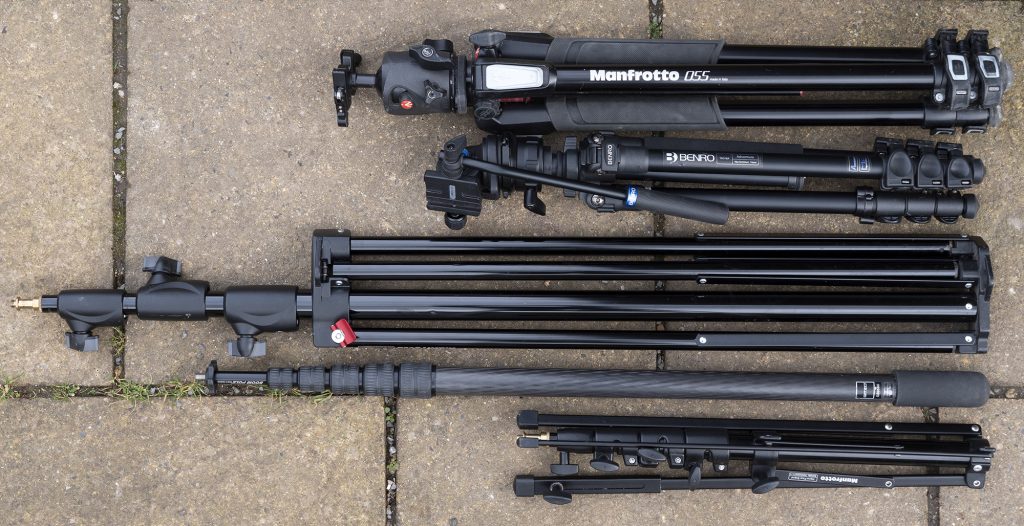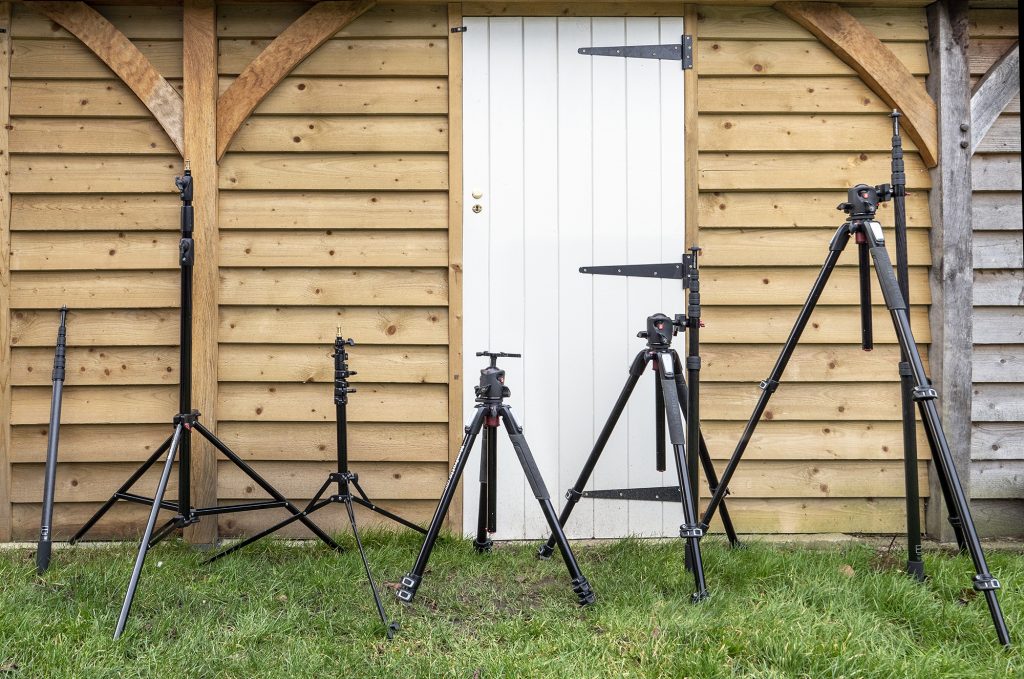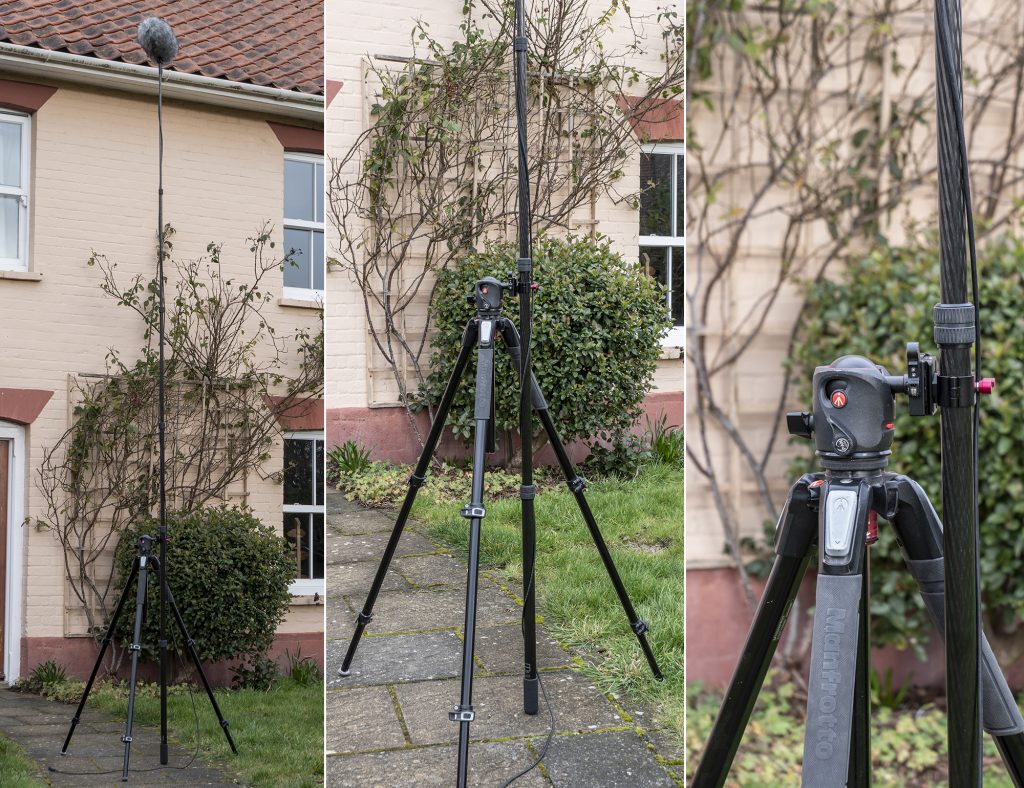
Field recording can mean mics on a pistol grip for a quick grab of a sound, on a boom pole for something equally quick but harder to reach, or clipped to a bag or hat for some stealthy ambience recording. But much recording outside – and that includes music – requires something more stable and static in the way of support so the mics can stay steady and the recordist can step right way to monitor from afar – not least to avoid capture of rustling, breathing and stomach gurgles from the recordist. Strapping mics to either side of a tree (‘tree ears’) can work, but, of course, there may not be a suitable tree to hand in the right place, so, mostly, it’s a case of taking a stand with you. The trouble with that, of course, is that there are no commercially available stands that have been purpose-built for field recording: so it’s a case of making do with what’s out there. In this post, I’m going to look at the conventional options I have been using in different situations, plus one additional option that I have put together recently and which others may want to try.
Mic stands
Conventional mic stands have little value outside unless in the tamest of environments (think streets, pavements, patios and lawns), being heavy and, with their circular or short fixed tripod bases, have no adaptability to uneven terrain. Not to be sniffed at if you have nothing else – and a short mic stand (the sort you might use for miking a kick drum or a guitar amp) could work fine for recording out in nature with mics near the ground – but not something I’ve found an attractive option.
Lighting stands
Lighting stands are great alternatives to mic stands indoors, not least for getting mics up high for, say, recording an organ, choir or orchestra: obviously they aren’t so good when you want a small footprint, or a short boom arm. They are also useful outdoors, and with a wide range of sizes, can cover a range of uses. When hiking/travelling light I often take a Manfrotto 5002 Nano Plus stand, which folds down to 52cm (it can fit in a rucksack with a blimp), yet extends to 1.97m. It has one slightly extendable foot so has a bit of adaptability to uneven terrain, though nothing very dramatic. It’s the beefiest of the Manfrotto Nano stands (taking a 4kg payload), but I can’t pretend it is rock solid: out in the wind anything above its shortest length is a bit hairy. I tried out the slightly lighter Manfrotto Nano Pole stand in the local camera shop, since it is lauded by some field recordists and looked good on-line, but it was not for me: it was so much flimsier than the 5002 Nano Plus stand and the removable centre column can hardly pass muster as a boom pole. At the taller end of the spectrum, I have a Manfrotto 1004BAC: this is my go to stand for recording acoustic music indoors when not close miking, and I’ve used it outdoors too many a time. It is in a different league than the little Nano Plus stand, rising to 3.66m and carrying up to 9kg (but still only weighing 3kg): it can happily support my chunky stereo bar and, even, my massive windshield for two LDC mics. Outside, though, it has the downside of lighting stands: the legs are designed for a flat surface and the tripod legs only rise a short way up the central pole or column, so it is prone to wobbliness and vibrations especially when extended.
Camera tripods
Many field recordists use camera tripods, and with good reason: the better engineering and, above all, the stability of legs rising much higher take away most of the wobbles and vibrations; many models can collapse far smaller than even the diminutive Nano lighting stands; many models can get mics close to the ground, unlike lighting stands; the legs are adjustable for length and angle, so the tripods can be used pretty much anywhere, even in water; and, of course, they can be used for their primary purpose too (less to carry, say, when hiking to the recording location). Obviously, adaptation is needed to connect mic clips/suspensions, or a stereo bar to the camera head (or remove that), but this is basic stuff: and use of quick-release plates means that you can swap from an audio to camera set up in seconds. There are a few downsides of varying significance: above all, camera tripods lack height, naturally enough being limited to average eye level or a little above; at full height the footprint of the tripod can be a bit large (not really an issue if, say, recording natural ambiences); with no full-height pole/column element, cable routing can be a bit fiddlier; and some tripods can take longer to set up than, say, a Nano Plus stand.

Boom pole with camera tripod
Advocates of the little Manfrotto Nano Pole stand often cite the removable centre column for use as a boom pole as a key attraction, although, as I said above, it’s a very poor substitute for a real boom pole and the stand itself is flimsy too. But the idea has merit: it is so handy having a boom pole in the field (great not just for any dialogue, but also for those hard to reach sounds – once you use a boom pole you will come to appreciate how many such sounds can be recorded, or better recorded, with the reach and the distance from you it provides – or when moving around, sans stand, catching quick close-up sounds) and it’s annoying carrying bits of kit that have very similar – and duplicated – elements to them. So it’s a pity that no manufacturer has scaled up the Nano Pole idea to produce a more stable stand, perhaps with leg geometry more like a camera tripod, with a decent-sized carbon-fibre boom pole at its core (or, better, the ability to incorporate a range of different boom poles from different manufacturers). I’ve looked for tripod legs that could be used to cobble together something with my boom pole, but with no joy. Then I had the idea (doubtless not the first or the last to do so) of mounting the boom pole to a camera tripod head with the bottom of the pole resting on the ground (crucial for giving stability), essentially making a four-legged stand. Looking around, the nearest thing I found to this out there is a tripod pole bracket made by Hague Camera Supports for attaching an aerial camera mast to a camera or video tripod: rather too massive and laborious for the sort of slick set up I had in mind, but it was reassuring to find someone thinking on similar lines. So to my rather smaller and quicker to use solution: a quick-release 30mm rod clamp (made by Camvate) fixed by two 1/4″ screws (i.e. ensuring no rotation) to an Arca-style quick-release plate. Both the plate and the clamp can be fixed to the tripod and the boom pole in seconds, and the pole can be set vertically or at an angle, with its bottom end firmly planted on the ground. It can be used with any of my Arca-fitted tripods – from the reasonably substantially Manfrotto 055 pro with large ball head, down to my little Benro travel tripod. And the advantage? Well I can use the tripod alone for mic support when convenient; I can use the boom pole alone when useful; and I can combine the two in seconds to get a far more stable tall stand than my current most substantial light stand (indeed, at 4m long, taller than my Manfrotto 1004BAC) with completely adjustable legs. It was a very blowy day today, so I was able to confirm stability in fairly extreme conditions (using Rycote Nano Shields with fur as windshields): at the 1.97m height of the Manfrotto 5002 Nano Plus stand it was completely stable, while the Manfrotto 1004BAC had a significant wobble, and the Nano Plus stand was worse still (both given extra stability by a heavy camera bag hung off them); and at the full 3.66m height of the 1004BAC the boom pole set up did wobble a bit, but less so than the lighting stand and, crucially, vibrations/wobbles calmed down much more quickly. Obviously, as would be expected, the advantage afforded by the taller legs of a camera tripod vs those of a lighting stand diminishes as the boom pole gets towards its maximum of 4m and also as the boom pole sections reduce, but it was interesting to see that the lighting stand didn’t out perform it at such height. For £30 for the rod clamp (and others may find/need different and better solutions for their boom pole), I have another flexible set-up to add to the choices when I take my sound gear out into the wilds, especially when I know the terrain won’t suit a lighting stand.


